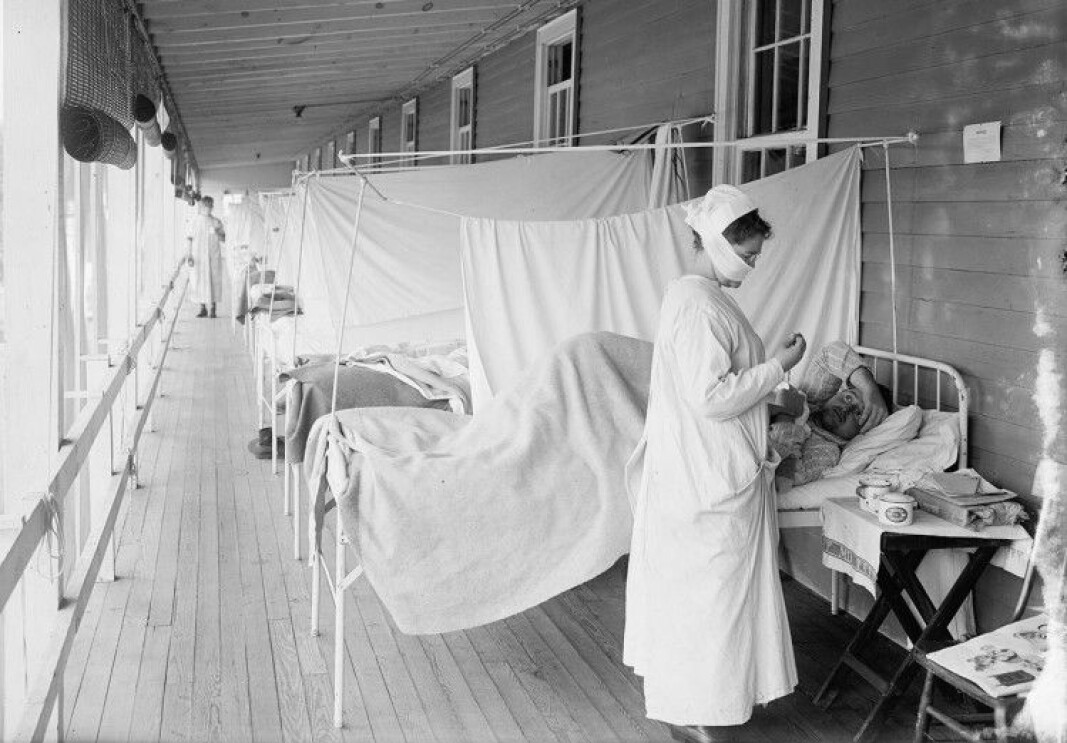
Do masks with antiviral coating offer more protection?
By The Associated Press
Do masks with antiviral coating offer more protection?
It’s an intriguing idea, but there haven’t been enough rigorous independent studies to establish whether antiviral masks are better at protecting wearers or preventing the spread of the virus.
Their specifics vary, but many antiviral masks are supposed to be made or coated with materials that have extra virus-fighting properties, such as copper.
Websites for several antiviral masks do not provide detailed information about how researchers tested their safety or effectiveness, said Hyo-Jick Choi, a materials science expert at the University of Alberta.
But it usually takes years to design and test new mask technology, said Choi, who is part of a group that has been developing a different type of antiviral mask since before the pandemic.
Masks marketed as being “antiviral” often cost more than N-95 and surgical masks. A single coated mask can cost up to $10; disposable surgical masks and N-95 masks sell at large retailers for between 35 cents and $3 per mask.
Choi said a simpler way to boost the effectiveness of the masks you’re already using is to ensure you’re putting them on, wearing them and taking them off correctly.
Full Coverage: Viral Questions
And no mask can fully protect wearers, “but almost any mask can help to protect others around the wearers,” said Jiaxing Huang, a professor of materials science and engineering at Northwestern University.
___
EXPLAINER:
What’s with the confusion over masks?
By ANDREW SELSKY

1 of 4
A sign in multiple languages encourages citizens to wear face coverings to help prevent the spread of COVID-19, Tuesday, Nov. 17, 2020, in Portland, Maine.
The World Health Organization changed its advice in June, and now says people should wear them when they can’t be socially distant.
WHAT ARE THE FEDERAL REQUIREMENTS ON MASKS?
In the United States, there are none. The CDC has made only recommendations.
And the attitude from the White House has been casual at best. Before the election, President Donald Trump often ridiculed his then Democratic opponent, Joe Biden, for wearing one whenever he was out in public. The president also held rallies that brought together thousands of supporters, most of them not wearing masks.
Biden, now president-elect, has said repeatedly that there should be a nationwide mask mandate. He has also promised to ask every governor to impose mask rules. For those who refuse, he’s vowed to go around them to seek similar mandates at the county or local level until the entire country is covered.
Some other countries have already mandated mask use, from requiring them everywhere in public to using them on public transportation and in stores.
Full Coverage: Viral Questions
HOW ARE U.S. STATES HANDLING THE SITUATION?
It’s a mix. As of Tuesday, 36 states have some type of mask mandate.
Republican governors in Iowa, North Dakota and Utah — all states that are being hit hard — have recently reversed course and required at least limited mask use. Others have extended or expanded earlier orders.
Iowa Gov. Kim Reynolds cast some doubt Tuesday on the science behind masks even as she imposed a limited mask rule, noting that neighboring states with mask mandates have seen rising numbers of cases, although not as severely as Iowa.
“If you look, you can find whatever you want to support wherever you are at,” she said.
In California, a more stringent mask mandate took effect on Tuesday. Democratic Gov. Gavin Newsom said residents will be required to cover up outdoors, with limited exceptions.
——
AP Medical Writer Mike Stobbe contributed to this story from New York.
___
Follow Andrew Selsky on Twitter at https://twitter.com/andrewselsky
By ANDREW SELSKY

1 of 4
A sign in multiple languages encourages citizens to wear face coverings to help prevent the spread of COVID-19, Tuesday, Nov. 17, 2020, in Portland, Maine.
(AP Photo/Robert F. Bukaty)
A lot of the effort to slow the spread of the coronavirus comes down to a seemingly simple concept: Wearing a mask.
But the issue has proven a thorny one. Health authorities have changed their guidance on who should wear masks and when to wear them. This has led to some confusion and even suspicion.
But since the coronavirus first appeared, authorities have gained a better understanding of how it spreads and how masks can help stop that spread.
Here’s a look at how what we know about masks has changed, and how government officials are increasingly getting behind the idea of mandating the use of masks.
WHAT DO THE EXPERTS SAY?
The U.S. Centers for Disease Control and Prevention has long advised people to wear masks because they help prevent people who are infected — whether they know it or not — from spreading the coronavirus.
But last week, the CDC added a new reason: masks can also protect wearers who are not infected, though to a lesser degree.
The agency referred to a study led by Japanese researchers that found masks block about 60% of the amount of virus that comes out of an infected person. When an uninfected person wearing a mask is near an infected person who isn’t wearing one, the amount of virus the uninfected person inhaled fell by up to 50%.
But when BOTH people are wearing masks, that produced the best result. The decline in virus particles reaching the second person was close to 70%.
So, if everyone wears a mask when social distancing is not feasible, the infection rate will be cut, experts say.
A study done in Denmark, published Wednesday in Annals of Internal Medicine, seemed to question whether and to what extent masks protect the wearer. The study had a number of flaws, however, as the researchers acknowledged. For example, study participants who were supposed to wear masks sometimes didn’t. And the work was done at a time when not much coronavirus was spreading in Denmark – meaning there wasn’t a lot of data to draw conclusions from.
Either way, experts say masks, while helpful, are not perfect. Keeping a distance, being in well-ventilated areas, and washing hands are also important ways to reduce risk.
A lot of the effort to slow the spread of the coronavirus comes down to a seemingly simple concept: Wearing a mask.
But the issue has proven a thorny one. Health authorities have changed their guidance on who should wear masks and when to wear them. This has led to some confusion and even suspicion.
But since the coronavirus first appeared, authorities have gained a better understanding of how it spreads and how masks can help stop that spread.
Here’s a look at how what we know about masks has changed, and how government officials are increasingly getting behind the idea of mandating the use of masks.
WHAT DO THE EXPERTS SAY?
The U.S. Centers for Disease Control and Prevention has long advised people to wear masks because they help prevent people who are infected — whether they know it or not — from spreading the coronavirus.
But last week, the CDC added a new reason: masks can also protect wearers who are not infected, though to a lesser degree.
The agency referred to a study led by Japanese researchers that found masks block about 60% of the amount of virus that comes out of an infected person. When an uninfected person wearing a mask is near an infected person who isn’t wearing one, the amount of virus the uninfected person inhaled fell by up to 50%.
But when BOTH people are wearing masks, that produced the best result. The decline in virus particles reaching the second person was close to 70%.
So, if everyone wears a mask when social distancing is not feasible, the infection rate will be cut, experts say.
A study done in Denmark, published Wednesday in Annals of Internal Medicine, seemed to question whether and to what extent masks protect the wearer. The study had a number of flaws, however, as the researchers acknowledged. For example, study participants who were supposed to wear masks sometimes didn’t. And the work was done at a time when not much coronavirus was spreading in Denmark – meaning there wasn’t a lot of data to draw conclusions from.
Either way, experts say masks, while helpful, are not perfect. Keeping a distance, being in well-ventilated areas, and washing hands are also important ways to reduce risk.
HOW IS THIS DIFFERENT FROM WHAT THEY’VE SAID BEFORE?
U.S. Surgeon General Jerome Adams tweeted on Feb. 29: “Seriously people — STOP BUYING MASKS! They are NOT effective in preventing general public from catching #Coronavirus”
But today, Adams has a different message pinned to the top of his Twitter account.
“When we can’t stay six feet away from others, please, I’m begging you, wear a face covering,” Adams says in the videotaped July 2 tweet.
And in July, the CDC stressed that cloth face coverings are a critical tool in the fight against COVID-19, particularly when everyone wears them.
Similarly, the World Health Organization early on had recommended against mask-wearing for the general public, saying they might lead to a false sense of security and that people who didn’t know how to use them properly could infect themselves.
U.S. Surgeon General Jerome Adams tweeted on Feb. 29: “Seriously people — STOP BUYING MASKS! They are NOT effective in preventing general public from catching #Coronavirus”
But today, Adams has a different message pinned to the top of his Twitter account.
“When we can’t stay six feet away from others, please, I’m begging you, wear a face covering,” Adams says in the videotaped July 2 tweet.
And in July, the CDC stressed that cloth face coverings are a critical tool in the fight against COVID-19, particularly when everyone wears them.
Similarly, the World Health Organization early on had recommended against mask-wearing for the general public, saying they might lead to a false sense of security and that people who didn’t know how to use them properly could infect themselves.
The World Health Organization changed its advice in June, and now says people should wear them when they can’t be socially distant.
WHAT ARE THE FEDERAL REQUIREMENTS ON MASKS?
In the United States, there are none. The CDC has made only recommendations.
And the attitude from the White House has been casual at best. Before the election, President Donald Trump often ridiculed his then Democratic opponent, Joe Biden, for wearing one whenever he was out in public. The president also held rallies that brought together thousands of supporters, most of them not wearing masks.
Biden, now president-elect, has said repeatedly that there should be a nationwide mask mandate. He has also promised to ask every governor to impose mask rules. For those who refuse, he’s vowed to go around them to seek similar mandates at the county or local level until the entire country is covered.
Some other countries have already mandated mask use, from requiring them everywhere in public to using them on public transportation and in stores.
Full Coverage: Viral Questions
HOW ARE U.S. STATES HANDLING THE SITUATION?
It’s a mix. As of Tuesday, 36 states have some type of mask mandate.
Republican governors in Iowa, North Dakota and Utah — all states that are being hit hard — have recently reversed course and required at least limited mask use. Others have extended or expanded earlier orders.
Iowa Gov. Kim Reynolds cast some doubt Tuesday on the science behind masks even as she imposed a limited mask rule, noting that neighboring states with mask mandates have seen rising numbers of cases, although not as severely as Iowa.
“If you look, you can find whatever you want to support wherever you are at,” she said.
In California, a more stringent mask mandate took effect on Tuesday. Democratic Gov. Gavin Newsom said residents will be required to cover up outdoors, with limited exceptions.
——
AP Medical Writer Mike Stobbe contributed to this story from New York.
___
Follow Andrew Selsky on Twitter at https://twitter.com/andrewselsky


















